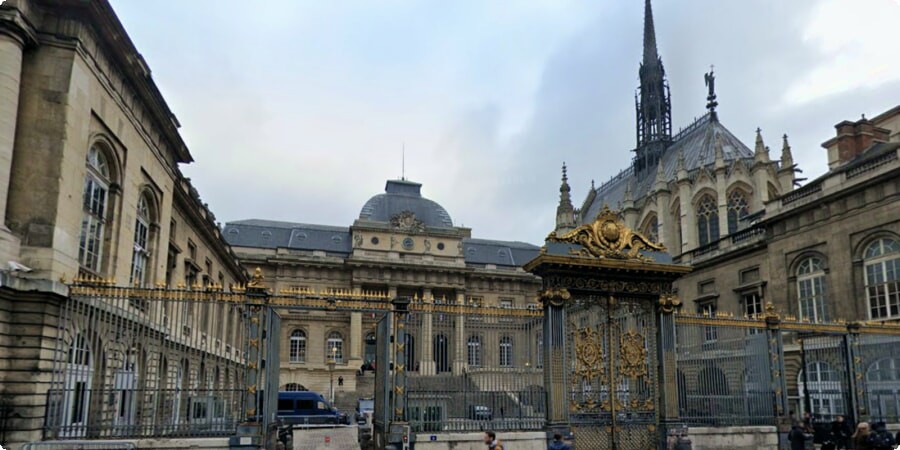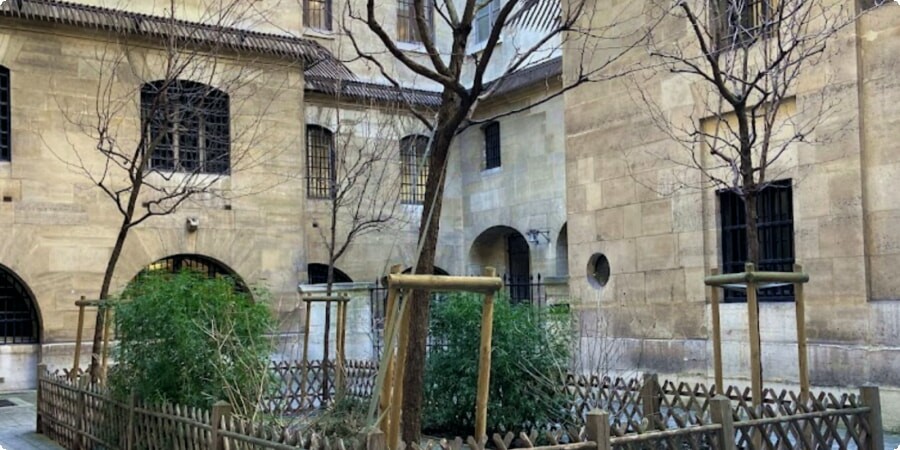The Conciergerie: A Fascinating Glimpse into Paris's Medieval Past
Welcome to the Conciergerie, a remarkable historical landmark nestled on the Île de la Cité in the heart of Paris. Stepping into the Conciergerie is like stepping back in time to the medieval era, where tales of kings, queens, and revolutionaries come to life within its ancient walls. This iconic monument offers visitors a unique opportunity to explore Paris's rich history and uncover the secrets of its medieval past.
History of the Conciergerie
The story of the Conciergerie begins over a thousand years ago when it was originally built as a royal palace by King Philip IV in the 14th century. Over the centuries, the Conciergerie underwent several transformations, serving as a residence for French kings and queens before eventually becoming a judicial center and prison.
During the French Revolution, the Conciergerie gained notoriety as a prison where thousands of political prisoners were held, including Marie Antoinette, the last queen of France. The prison's grim reputation as a place of injustice and suffering has made it a symbol of the revolution and a poignant reminder of France's turbulent past.
Architecture and Design
The architecture of the Conciergerie is a testament to the grandeur and elegance of Gothic design. Its imposing façade, with its soaring towers and intricate stonework, commands attention and evokes a sense of awe and reverence. Inside, visitors are greeted by a series of magnificent halls and chambers adorned with ornate carvings, vaulted ceilings, and stained glass windows.
One of the most striking features of the Conciergerie is its Hall of the Guards, a vast space that once served as the royal residence's main reception hall. Today, the hall offers a glimpse into the splendor of medieval court life and provides a stunning backdrop for exhibitions and events.

And if you're planning to explore more of Paris's historical landmarks and attractions, consider booking a car through Cars4Travel for convenient transportation and the freedom to discover the city at your own pace.
Role in French History
The Conciergerie has played a pivotal role in shaping French history, serving as a royal palace, a judicial center, and a prison throughout different periods. Here are some key highlights of its historical significance:
-
Royal Residence: In its early days, the Conciergerie was a luxurious royal residence where French kings and queens resided. The opulent interiors and lavish furnishings reflected the wealth and power of the monarchy, making it a symbol of royal prestige and authority.
-
Judicial Center: As the seat of the Parlement de Paris, the Conciergerie was a center of judicial activity where important legal proceedings and trials took place. The grandeur of the palace's halls and chambers provided a fitting backdrop for the administration of justice and the enforcement of law and order.
-
Prison of the Revolution: During the French Revolution, the Conciergerie gained notoriety as a prison where thousands of political prisoners were held in deplorable conditions. Many of the revolution's most prominent figures, including Marie Antoinette and Maximilien Robespierre, spent their final days within its walls before facing the guillotine.
-
Symbol of Resistance: Despite its dark history as a place of incarceration and execution, the Conciergerie also serves as a symbol of resistance and resilience. The stories of courage and defiance exhibited by its prisoners have inspired generations of French citizens to stand up for their beliefs and fight for justice and liberty.
The Conciergerie's multifaceted role in French history offers a fascinating glimpse into the complexities of the past and the enduring legacy of the revolution.

Notable Prisoners and Trials
Throughout its history, the Conciergerie has been home to a diverse cast of prisoners, from royalty and nobility to revolutionaries and commoners. Here are some of the most notable prisoners and trials associated with the Conciergerie:
-
Marie Antoinette: Perhaps the most famous prisoner held at the Conciergerie, Marie Antoinette, the last queen of France, was imprisoned here during the French Revolution. She faced trial for treason and was ultimately sentenced to death by guillotine.
-
Maximilien Robespierre: As one of the key figures of the revolution, Robespierre found himself on the other side of the law when he was arrested and imprisoned in the Conciergerie. His trial and subsequent execution marked the end of the Reign of Terror and the beginning of a new chapter in French history.
-
The Girondins: A group of moderate revolutionaries known as the Girondins were also held at the Conciergerie during the revolution. Their trial and eventual execution were part of the government's efforts to eliminate political opposition and consolidate power.
-
The Dreyfus Affair: In the late 19th century, the Conciergerie played a role in one of France's most infamous miscarriages of justice—the Dreyfus Affair. Captain Alfred Dreyfus, a Jewish officer in the French army, was wrongfully convicted of treason and imprisoned at the Conciergerie before being exonerated years later.
The trials and tribulations of these famous prisoners offer a window into the tumultuous history of France and the enduring struggle for freedom and justice.

Daily Life in the Conciergerie
Life within the walls of the Conciergerie was harsh and unforgiving for its prisoners, who faced overcrowding, unsanitary conditions, and the constant threat of execution. Here's a glimpse into the daily life of inmates at the Conciergerie:
-
Living Conditions: Prisoners at the Conciergerie were housed in cramped cells with little to no privacy or comfort. Many slept on straw mattresses on the cold stone floors, while others shared small chambers with multiple inmates.
-
Routine and Rations: Daily life in the Conciergerie followed a strict routine, with prisoners rising early for roll call and spending the day engaged in menial labor or awaiting trial. Food rations were meager and often of poor quality, leading to malnutrition and illness among the inmates.
-
Interactions and Relationships: Despite the grim conditions, prisoners at the Conciergerie formed bonds of camaraderie and solidarity with their fellow inmates. They shared stories, offered support, and found solace in each other's company amid the hardships of prison life.
-
Legal Proceedings: For those awaiting trial, the Conciergerie was a place of uncertainty and anxiety as they awaited their fate. The judicial process was slow and unpredictable, with many prisoners languishing in limbo for months or even years before their cases were heard.
Booking a car in France can provide you with the flexibility and convenience to explore the city and its surrounding areas at your own pace. Consider booking through Cars4Travel for a seamless travel experience.

Restoration and Preservation Efforts
Preserving the historical integrity of the Conciergerie is a priority for conservationists and heritage organizations. Here are some of the ongoing restoration and preservation efforts aimed at safeguarding this iconic landmark:
-
Architectural Restoration: Skilled craftsmen and restoration experts work tirelessly to repair and maintain the Conciergerie's architectural elements, including its Gothic facades, vaulted ceilings, and ornate carvings. Using traditional techniques and materials, they ensure that the palace retains its original grandeur and charm.
-
Conservation of Artifacts: The Conciergerie's vast collection of artifacts, including furniture, artwork, and historical documents, requires careful conservation to prevent deterioration and damage. Conservationists employ specialized methods and technologies to preserve these precious objects for future generations to enjoy.
-
Educational Programs: Educational programs and guided tours offer visitors the opportunity to learn about the history and significance of the Conciergerie and its role in French history. Through interactive exhibits, workshops, and lectures, visitors of all ages can deepen their understanding of the palace's rich cultural heritage.
-
Community Engagement: Local community groups and volunteers play a vital role in supporting the preservation efforts at the Conciergerie. Through fundraising events, awareness campaigns, and hands-on conservation projects, they help raise awareness of the palace's historical importance and promote a sense of ownership and pride among the public.
By prioritizing restoration and preservation efforts, the Conciergerie continues to stand as a shining example of France's rich cultural heritage and a testament to the resilience of its medieval past.
Visitor Experience
Visiting the Conciergerie is a memorable experience that offers a fascinating glimpse into Paris's medieval past. Here are some tips and recommendations to make the most of your visit:
-
Guided Tours: Take advantage of guided tours led by knowledgeable experts who can provide insights into the history, architecture, and significance of the Conciergerie. These tours offer a deeper understanding of the palace's role in French history and its impact on the world.
-
Interactive Exhibits: Explore interactive exhibits and multimedia installations that bring the history of the Conciergerie to life. From immersive reenactments to virtual reality experiences, these exhibits offer a unique and engaging way to learn about the palace's past.
-
Audio Guides: Audio guides are available in multiple languages and provide informative commentary as you explore the Conciergerie at your own pace. Listen to fascinating stories and anecdotes about the palace's famous inhabitants and historical events as you wander through its halls and chambers.
-
Special Events: Keep an eye out for special events and exhibitions happening at the Conciergerie throughout the year. From temporary art installations to historical reenactments, there's always something exciting happening at the palace.
The Conciergerie is more than just a historical landmark; it's a source of inspiration and wonder that captures the imagination of all who visit. Whether you're drawn to its majestic architecture, its rich history, or its poignant reminders of the human experience, there's something about the Conciergerie that leaves a lasting impression.
As you explore this remarkable palace and immerse yourself in its storied past, take a moment to reflect on the resilience of the human spirit and the enduring legacy of France's medieval heritage. Let the stories of the Conciergerie's past inhabitants inspire you to embrace the challenges of the present and to cherish the beauty and complexity of the world around you.